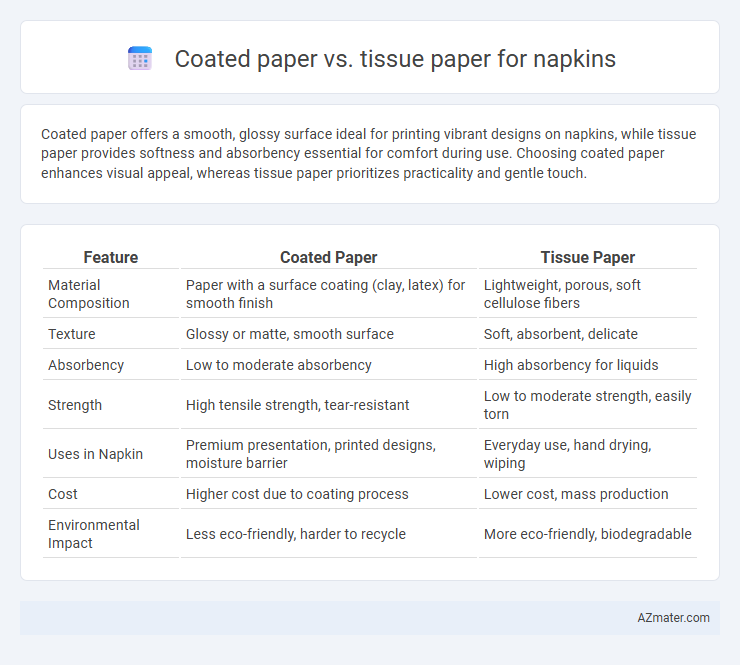Coated paper offers a smooth, glossy surface ideal for printing vibrant designs on napkins, while tissue paper provides softness and absorbency essential for comfort during use. Choosing coated paper enhances visual appeal, whereas tissue paper prioritizes practicality and gentle touch.
Table of Comparison
| Feature | Coated Paper | Tissue Paper |
|---|---|---|
| Material Composition | Paper with a surface coating (clay, latex) for smooth finish | Lightweight, porous, soft cellulose fibers |
| Texture | Glossy or matte, smooth surface | Soft, absorbent, delicate |
| Absorbency | Low to moderate absorbency | High absorbency for liquids |
| Strength | High tensile strength, tear-resistant | Low to moderate strength, easily torn |
| Uses in Napkin | Premium presentation, printed designs, moisture barrier | Everyday use, hand drying, wiping |
| Cost | Higher cost due to coating process | Lower cost, mass production |
| Environmental Impact | Less eco-friendly, harder to recycle | More eco-friendly, biodegradable |
Introduction to Napkin Materials
Coated paper napkins offer a smooth surface treated with a polymer layer, enhancing durability and resistance to moisture, making them ideal for spill-prone environments. Tissue paper napkins are softer, more absorbent, and biodegradable, commonly used for everyday dining and events emphasizing sustainability. Material choice impacts napkin performance, user comfort, and environmental footprint in hospitality and catering industries.
Understanding Coated Paper for Napkins
Coated paper for napkins features a smooth, sealed surface that enhances print quality and resists moisture, making it ideal for decorative purposes and spill prevention. Its clay or polymer coating improves durability and provides a polished finish, distinguishing it from the softer, more absorbent tissue paper typically used for everyday napkins. The coated paper's balance of strength and aesthetics makes it suitable for upscale dining settings where appearance and functionality are both priorities.
What is Tissue Paper Napkin?
Tissue paper napkins are soft, lightweight, and absorbent products primarily made from natural fibers like cellulose, designed for single-use and personal hygiene purposes. Unlike coated paper napkins, which have a plastic or wax layer for durability and moisture resistance, tissue paper napkins prioritize softness and biodegradability. Their delicate texture makes them ideal for facial use, dining, and decorative applications, enhancing comfort while minimizing environmental impact.
Absorbency: Coated Paper vs Tissue Paper
Tissue paper napkins offer superior absorbency due to their porous fibers, which quickly soak up liquids and moisture. Coated paper napkins feature a thin, hydrophobic layer that repels moisture, reducing their absorbent capacity but enhancing durability and resistance to sogginess. For high absorbency needs, tissue paper napkins are ideal, while coated paper napkins provide a balance of strength and moderate moisture resistance.
Softness and Comfort: Comparing Feel
Tissue paper napkins offer superior softness and comfort due to their lightweight and porous texture, making them gentle on the skin and ideal for facial use. Coated paper napkins have a smoother surface with a thin plastic or wax layer, providing a sturdier feel but less softness compared to tissue paper. The choice between coated and tissue paper napkins depends on the priority of comfort versus durability for specific uses.
Durability and Strength Differences
Coated paper napkins exhibit higher durability and strength due to their surface treatments that enhance resistance to moisture and tearing, making them ideal for heavy-duty use. Tissue paper napkins, being uncoated and thinner, offer less tensile strength and are more prone to ripping when wet, which suits them better for light, disposable applications. The coating process in coated paper significantly increases fiber bonding, resulting in superior structural integrity compared to tissue paper.
Print Quality and Customization
Coated paper for napkins offers superior print quality with vibrant colors and sharp details, making it ideal for custom designs and branding. Tissue paper, while softer and more absorbent, generally provides a less defined print due to its porous texture, limiting intricate customization options. Choosing coated paper enhances visual impact and detail precision, whereas tissue paper prioritizes comfort but may sacrifice print clarity.
Environmental Impact and Sustainability
Coated paper napkins, often treated with plastic or chemical coatings, hinder recyclability and contribute to microplastic pollution, making them less eco-friendly compared to tissue paper. Tissue paper napkins, typically biodegradable and compostable, support sustainable waste management and reduce landfill burden due to their natural fibers and minimal processing. Choosing unbleached or recycled tissue paper further enhances environmental benefits by lowering carbon footprint and conserving natural resources.
Cost Analysis: Coated vs Tissue Paper Napkins
Coated paper napkins generally incur higher production costs due to specialized coating processes and materials used to enhance durability and moisture resistance. Tissue paper napkins offer a cost-effective alternative with lower raw material expenses and simpler manufacturing techniques, making them preferred for bulk or daily use scenarios. Choosing between coated and tissue paper napkins depends largely on budget constraints and required functionality, with coated variants commanding premium pricing for enhanced quality.
Choosing the Right Napkin Material for Your Needs
Coated paper napkins offer superior durability and moisture resistance, making them ideal for meals with sauces or beverages, while tissue paper napkins provide softness and absorbency suited for light use and facial wiping. Selecting the right napkin material depends on the specific requirements of your event, such as the level of absorbency, texture preference, and cost considerations. For heavy-duty dining, coated paper ensures sturdiness, whereas tissue paper napkins excel in comfort and gentle use.

Infographic: Coated paper vs Tissue paper for Napkin
 azmater.com
azmater.com